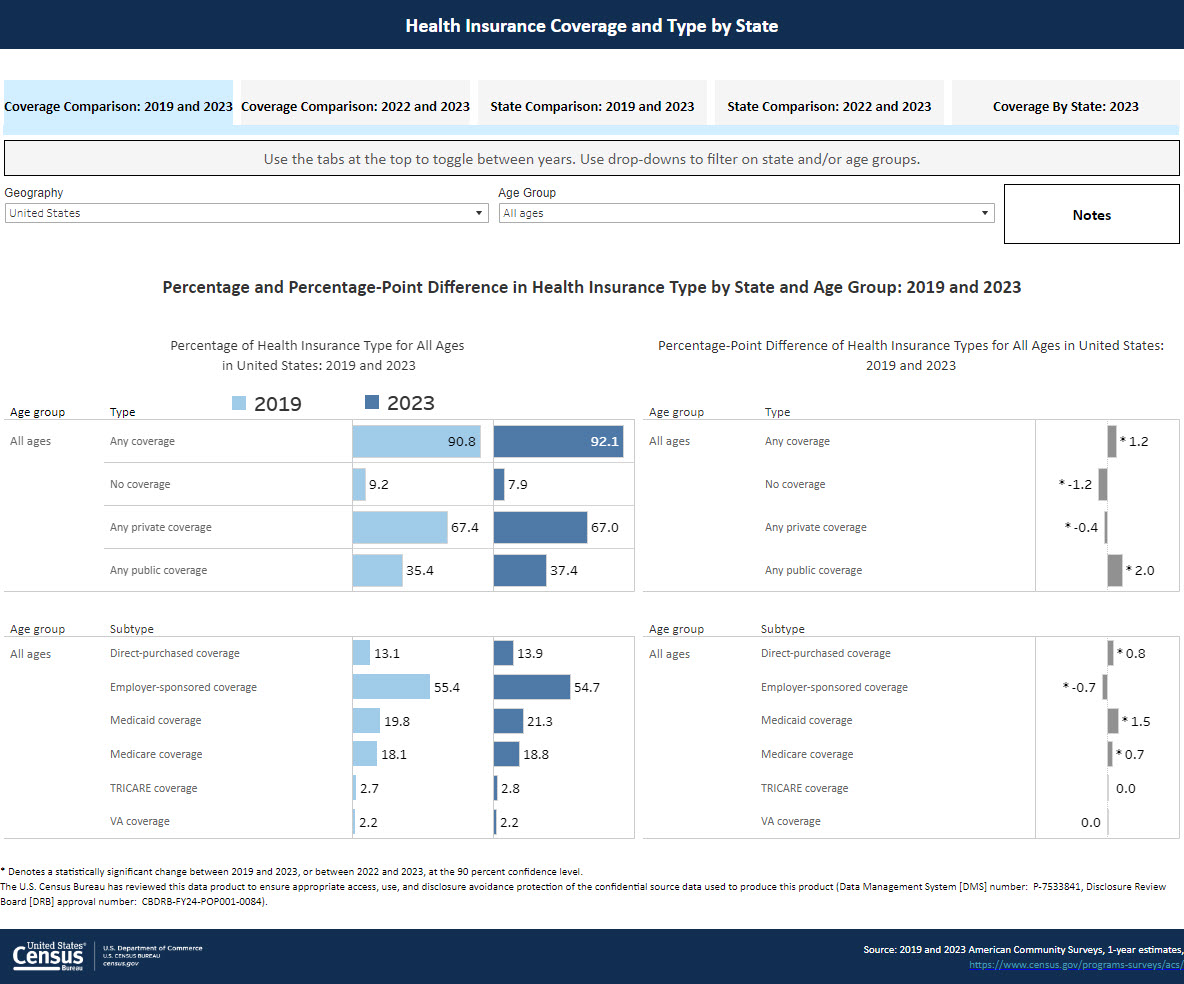Most Declines in Uninsured Rates for All Age Groups Occurred Between 2013 and 2019
Many states continued to see improvements in health insurance coverage rates for all age groups between 2019 and 2023, according to American Community Survey (ACS) data released today.
Uninsured rates dropped in 17 states for children, 42 states for working-age adults, and in one state (Florida) for adults age 65 and older from 2019 to 2023.
Because many public health insurance programs are aimed specifically at coverage for children, older adults, and those in need, the uninsured rate among working-age adults ages 19 to 64 is higher.
But fewer states saw drops in uninsured rates than from 2013 to 2019, when rates declined in 37 states for children, in all 50 states and the District of Columbia for working-age adults, and in 14 states for older adults.
The report, State Health Insurance Coverage: 2013, 2019, and 2023, highlights changes in the health insurance landscape across the states in the past decade, from the implementation of key provisions of the Patient Protection and Affordable Care Act (ACA) through the COVID-19 pandemic and resulting economic and policy changes.
An interactive dashboard also released today focuses on the 2022 to 2023 changes as well as the 2019 to 2023 changes across the states. A companion working paper further examines the working-age adult population by smaller age groups across states.
Health Policies and Health Coverage
Health insurance policies at the federal and state level affect the availability and affordability of health coverage.
The ACA was signed into law in 2010 and major provisions of ACA that went into effect before 2019 may have impacted uninsured rates between 2013 and 2019.
They included offering states additional funds to expand Medicaid for those under age 65 with incomes up to 133% of the federal poverty level and establishing health insurance marketplaces for those seeking to purchase coverage.
While the ACA included an individual mandate requiring every person to have health insurance, the tax penalty for uninsured individuals was removed in 2019.
The COVID-19 pandemic in 2020 spurred the passing of the Families First Coronavirus Response Act, which mandated that states provide continuous eligibility for individuals enrolled in Medicaid on or after March 8, 2020. Most of these pandemic-related provisions expired in mid-2023.
Health Coverage for Children Under Age 19
Age is an important factor in eligibility for health insurance coverage. Children may have access to a variety of public health insurance coverage types, such as Medicaid or Children’s Health Insurance Program (CHIP) or dependent coverage under a parent’s employer or direct purchase plan.
Between 2013 and 2019:
- The uninsured rate for children decreased in 37 states.
- Private coverage rates for children increased in 20 states.
- Public coverage rates for children increased in 22 states.
Between 2019 and 2023:
- The uninsured rate for children decreased in 17 states.
- Private coverage rates for children increased in 9 states.
- Public coverage rates for children increased in 24 states.
How Uninsured Rates Changed for Working-Age Adults
Because many public health insurance programs are aimed specifically at coverage for children, older adults, and those in need, the uninsured rate among working-age adults ages 19 to 64 is higher.
Provisions of the ACA expanded coverage options for younger adults via the healthcare marketplace and through their parent’s health insurance coverage if they were under age 26.
The uninsured rate for the total working-age adult population fell in every state plus the District of Columbia between 2013 and 2019:
- For adults ages 19 to 25, it decreased between 2.4 and 18.2 percentage points across 48 states.
- For adults ages 26 to 34, it decreased between 1.3 and 17.4 percentage points across 49 states and the District of Columbia.
- For adults ages 35 to 44, it decreased in 48 states and the District of Columbia, with declines ranging from 0.8 to 14.2 percentage points.
- For adults ages 45 to 54, it decreased between 0.8 and 9.9 percentage points in 48 states and the District of Columbia.
- For working-age adults ages 55 to 64, it decreased between 1.8 to 9.5 percentage points across 46 states and the District of Columbia.
The uninsured rate for the total working-age population decreased in 42 states between 2019 and 2023.
- For adults ages 19 to 25, it decreased between 1.4 and 5.6 percentage points across 24 states and the District of Columbia and increased in one (Montana).
- For adults ages 26 to 34, it decreased between 1.1 and 8.2 percentage points across 35 states.
- For adults ages 35 to 44, it decreased in 35 states, with declines ranging from 0.7 and 4.2 percentage points.
- For adults ages 45 to 54, it decreased between 0.9 and 5.1 percentage points across 31 states and increased in one (Maryland).
- For the oldest working-age adults ages 55 to 64, it decreased between 0.4 and 3.6 percentage points across 28 states and increased in one (Rhode Island).
How Private Coverage Changed for Adults Age 65 and Older
Adults age 65 and older are the least likely age group to be uninsured since they have near universal Medicare coverage.
As a result, the uninsured rate for adults age 65 and over remained below 3.0% for all states in 2013, 2019 and 2023. A smaller percentage of older adults have some type of private coverage, either through a combination of public and private health insurance plans or, in rare instances, private coverage alone.
Private coverage for adults age 65 and older between 2013 and 2019:
- Rates decreased in 48 states, rising in none.
- In 2013, rates ranged from 53.4% to 76.5% across the states and the District of Columbia.
Private coverage rates for adults age 65 and older between 2019 and 2023:
- Rates declined in 42 states, ranging between 2.2 and 7.6 percentage points.
- By 2023, rates for these adults ranged from 46.6% to 69.1% across the states and the District of Columbia.
Changes Across States Between 2022 and 2023
The interactive visualization includes a dashboard comparing 2022 and 2023 ACS, 1-year estimates of health insurance coverage and subtypes. Among the findings:
- The uninsured rate for children increased in six states: Alabama, Louisiana, New Mexico, South Carolina, Texas and Washington.
- Medicaid coverage for children declined in seven states: Arkansas, Florida, Idaho, Illinois, Maryland, Texas and West Virginia. It increased in five: Iowa, Missouri, New Mexico, Tennessee and Wyoming.
- Uninsured rates for working-age adults declined in 14 states and increased in three: Connecticut, Iowa and New Jersey.
- Medicaid coverage for working-age adults increased in 11 states and decreased in four: Arkansas, Idaho, New Hampshire and West Virginia.
- Private coverage for adults 65 years and older declined in 24 states, driven by declines in direct-purchase coverage.
Note: Select the image to go to the interactive data visualization.
Related Statistics
Subscribe
Our email newsletter is sent out on the day we publish a story. Get an alert directly in your inbox to read, share and blog about our newest stories.
Contact our Public Information Office for media inquiries or interviews.
-
Rental HousingLargest Annual Real Increase in Gross Rental Costs Since 2011September 12, 2024Despite an increase in the cost of rent and utilities, most states saw no significant change in the share of renters’ income spent on rent.
-
Income and PovertyOlder Adults and Child Poverty Rates Changed in Many States in 2023September 12, 2024American Community Survey data released today show that despite a decline in child poverty rates in 2023, they remain higher than other age groups.
-
Business and EconomyHow Many U.S. Businesses Offer Health Insurance to Employees?February 29, 2024Private-sector companies in seven states and District of Columbia offer health insurance to employees at a rate significantly above the national average.
-
EmploymentThe Stories Behind Census Numbers in 2025December 22, 2025A year-end review of America Counts stories on everything from families and housing to business and income.
-
Families and Living ArrangementsMore First-Time Moms Live With an Unmarried PartnerDecember 16, 2025About a quarter of all first-time mothers were cohabiting at the time of childbirth in the early 2020s. College-educated moms were more likely to be married.
-
Business and EconomyState Governments Parlay Sports Betting Into Tax WindfallDecember 10, 2025Total state-level sports betting tax revenues has increased 382% since the third quarter of 2021, when data collection began.
-
EmploymentU.S. Workforce is Aging, Especially in Some FirmsDecember 02, 2025Firms in sectors like utilities and manufacturing and states like Maine are more likely to have a high share of workers over age 55.






